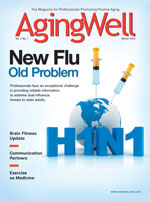Winter 2010 Facts on Fats Help patients understand the types of dietary fats and their influence on heart health. Fat is often a misunderstood nutrient. On one hand, popular diets such as Pritikin call for reducing fat in the diet to a bare minimum, consuming only 10% or fewer calories from fat. The Atkins diet, on the other hand, at its lowest level encourages only 20 g of carbohydrates per day (compared with 250 to 300 g/day in a recommended healthful diet) and consists largely of higher levels of protein and fat. With such conflicting messages, older adults are sometimes confused regarding the level of fat that is healthful. In addition, numerous terms designate various types of dietary fat—polyunsaturated, monounsaturated, saturated—words that sound more at home in a chemistry lab than a kitchen. It all adds up to dietary fat confusion. A recent survey of 6,426 18- to 70-year-olds from 16 countries illustrated some of the confusion. Results published in the July 2009 issue of the Annals of Nutrition and Metabolism indicate that 59% of respondents believe fat should be avoided; 65% believe a low-fat diet is a healthful diet; and 38% avoid foods containing fats. Respondents were aware of the different types of fats but not the ways in which each type impacts health. Omega fatty acids had the greatest level of recognition; however, many of the respondents didn’t realize they were fats. What Is Dietary Fat? The chemical structure of a fat begins with a backbone of carbon atoms. Glycerol and three fatty acids attach to this, resulting in a triglyceride. If there are no hydrogen molecules missing from any of the fatty acids, the fat is called saturated. Saturated fats are solid at room temperature and are found in animal and dairy products, as well as coconut and palm oils. If a single pair of hydrogen molecules is missing from a fatty acid, the fat is called monounsaturated. Foods such as avocados, nuts, and olive oils contain monounsaturated fats. Finally, if two or more pairs of hydrogen molecules are missing, the fat is polyunsaturated. Many plant-based oils such as canola, safflower, sunflower, and corn are polyunsaturated fats. Health and Fat Intake It’s never too late to lower risk factors for CHD. According to an article published in the May 2009 issue of the British Journal of Community Nursing, evidence from epidemiological studies indicates that the same factors associated with an increased risk of CHD in middle-aged individuals are relevant in older adults. Clinical trials have shown that changing these risk factors in older adults can reduce CHD risk as effectively as it does in middle-aged adults. Right Amounts and Types of Fats The 2005 Dietary Guidelines for Americans recommends a total dietary fat intake between 20% and 35% of total calories, with saturated fat consumption of less than 10% of total calories, cholesterol intake of less than 300 mg/day, and trans fatty acid consumption as low as possible. How does this translate into guidelines for reading food labels? The first step is calculating calorie requirements. Calorie intake depends on an individual’s height, weight, age, and level of physical activity. However, the Institute of Medicine calculates the estimated energy requirement of moderately active women aged 51 and older at 2,000 kcal/day and 2,200 to 2,400 kcal/day for men of similar activity and age. This suggests that women should limit total fat intake to between 45 and 78 g/day and men should limit fat intake to between 50 and 93 g/day. Fats and oils, protein foods such as meats and poultry, and dairy foods provide the greatest amounts of fat in the diet. Trans fats or unsaturated fats have a chemical configuration in which the hydrogen atoms around the carbon backbone are of either a cis or trans shape. The problem with trans fats is that they can raise the “bad,” or LDL, portion of total cholesterol in the blood while lowering the “good,” or HDL portion. Trans fatty acids are found naturally in foods such as beef, pork, lamb, full-fat milk, cheese, and butter. Trans fatty acids are also formed in foods such as margarine and shortening when these foods undergo a process called hydrogenation. Foods made with these fats, such as cakes, cookies, crackers, pastries, muffins, doughnuts, pies, and French fries, contain trans fats. Like total fat, saturated fat, and cholesterol, the trans fat content of foods is listed on food labels. Omega-3 Fatty Acids Beyond CHD, research suggests that omega-3 fatty acids may also reduce the risk of developing certain cancers, lessen complications from metabolic syndrome and diabetes, improve bone health, and lessen the risk for dementia in older adults. The Bottom Line — Carol M. Bareuther, RD, is a St. Thomas, U.S. Virgin Islands-based writer who contributes to a variety of regional, national, and international publications. |

